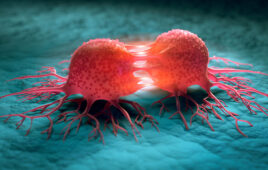Several small molecule and antibody-based targeted cancer therapies are on the market and others are in the pipeline. Determining how targeted to be, however, is still a challenge.
Patrick McGee, Senior Editor
Treating cancer with chemotherapeutic drugs has a proven track record and is very effective. Most of these cytotoxic drugs work by impairing mitosis. But they have a “shotgun” effect, so while they prevent cancers from spreading, they also affect the division of healthy cells, resulting in serious side effects such as immunosuppression, nausea, and vomiting. Researchers and clinicians have long dreamed of more targeted drugs, ones that would root out cancers at the molecular or signal-pathway level.
Over the last decade, the mapping of the human genome, along with improved understanding of signal transduction and the pathways responsible for tumor survival, have transformed targeted therapies in
oncology from a concept to a reality. In 1997, Herceptin (trastuzumab) became the first targeted therapy for breast cancer, specifically for HER2-positive metastatic breast cancer. Herceptin is an injectable antibody made by Genentech Inc., South San Francisco, Calif., which targets and blocks the function of HER2 protein over-expression. In 2001, Gleevec (imatinib mesylate), made by Novartis AG, Basel, Switzerland, became the first approved kinase inhibitor for cancer, specifically chronic myeloid leukemia (CML), and it has since been approved for the treatment of gastrointestinal stromal tumors (GIST). Over the last few years, several other targeted cancer therapies have entered the marketplace.
“All signs point to a growing understanding and use of proteomic, genetic, and pharmacogenomic tools to advance the concept of more personalized medicines,” says Rick Lesniewski, PhD, director of cancer research at Abbott Laboratories, Abbott Park, Ill. “We believe there will be a strong convergence of molecular diagnostics and molecularly targeted therapeutics that will result in significant efficiencies, bringing important new oncology drugs through the development process, and then matching them to those patients who will derive true clinical benefit from these drugs.”
Steve Arkinstall, D.Phil, vice president of research, United States, for Serono Research Institute, Rockland, Mass., says scientists have learned more and more about the pathways responsible for tumor survival and death. “Those, of course, are potential drug targets. What’s happening now is that there are a lot more studies being applied to real clinical samples, in other words real clinical tumors, to help understand which targets within those pathways are up-regulated and/or activated, or which lie within pathways which are activated and themselves are druggable and can be used as targets.”
Biomarker research
Another key emerging trend is the use of biomarkers, a strategy that complements targeted therapy development, says Lesniewski, who adds that Abbott uses biomarker research with all preclinical and clinical oncology compounds to make drug development more efficient. Their goal is twofold: to identify patients who are most likely to achieve clinical benefit and to determine an optimal dose at which a full biological effect is seen. “The need for such pharmacodynamic markers of biological effect is critical with the emergence of much safer, targeted therapies, for which the concept of dosing to a maximum tolerated dose may not be feasible or even useful.”
Another trend, Lesniewski says, is the development of companion diagnostics as researchers look for better methods to determine which patients will benefit from specific
 click the image to enlarge DU145 cells, a human prostate cancer cell line used by many labs, genetically engineered to express a fluorescent marker. (Source: Phillip Febbo, MD) |
drugs (see related story on page 30). “As cancer drug development focuses increasingly on specific molecular targets, it becomes more feasible to link patients to the appropriate therapies for their disease using a diagnostic assay designed to detect the presence/absence or specific alteration in these molecular drug targets.” For example, Abbott’s PathVysion HER-2 test identifies breast cancer patients with an amplification of the HER-2 gene, a factor that makes them candidates for treatment with Herceptin.
Genomic research has also had an impact on the field and will continue to do so, says Scott Armstrong, MD, PhD, assistant professor of pediatrics at Harvard Medical School, Cambridge, Mass., and researcher at the Dana-Farber Cancer Institute in Boston. Of particular interest is the recent announcement that the National Cancer Institute and the National Human Genome Research Institute would initiate a pilot project to determine the feasibility of systematically exploring the genomic changes involved in all types of human cancer. “One of the major goals of this is to find the abnormal kinase that is presumed to be present in many different types of cancers, because we know how to develop drugs against those based on the Gleevec and the EGF [epidermal growth factor] receptor-inhibitor paradigm.”
Targeting the market
Improved knowledge of genomic changes involved in many cancers could help increase the number of targeted cancer therapies. These fall into two categories, monoclonal antibodies or small molecules, and most are kinase inhibitors. Herceptin, for example, is a monoclonal antibody. Early in 2004, the US Food and Drug Administration (FDA) approved two new targeted monoclonal antibodies for cancer. Erbitux (cetuximab) was the first approved for patients with advanced colorectal cancer that has spread to other parts of the body. Erbitux, a product of ImClone Systems Inc., New York, and Bristol-Myers Squibb (BMS), Princeton, N.J., is a genetically engineered version of a mouse antibody that contains both human and mouse components. It works by targeting EGFR on the surface of cancer cells, thus interfering with their growth.
Another monoclonal antibody, Avastin (bevacizumab), was approved as a first-line treatment for patients with metastatic colorectal cancer and was the first drug that works by preventing angiogenesis. Avastin, which is made by Genentech, targets and inhibits the function of vascular endothelial growth factor (VEGF), which stimulates new blood vessel formation. When VEGF is targeted and bound to Avastin, it cannot stimulate the growth of blood vessels, so tumors are denied blood, oxygen, and other nutrients needed for growth.
While monoclonal antibodies have proven effective, small-molecule kinase inhibitors such as Gleevec seem to have generated more excitement and interest. “Gleevec was the first targeted cancer therapy developed based on knowledge that came from understanding the genetic basis of the disease,” says Armstrong. “You know the genetic basis of the disease, you know what that does at a functional standpoint, you develop a small molecule to inhibit that, and in fact it works. It’s rational drug design. It was the first time that approach was proven successful in cancer therapy.” Armstrong adds that until Gleevec’s approval, many cancer biologists doubted that targeted cancer therapies could be developed.
Gleevec was initially approved for treating CML, a rare cancer, and works by inhibiting the BCR-ABL kinase, the cause of chronic phase CML. It was later approved for GIST. “Gleevec is an example where understanding the activity of the molecules or inhibitors and having a deep understanding of their biochemical and biological activity enables various therapeutic indications to be targeted with those therapies. That’s a continuing trend,” says Jonathan Yingling, PhD, chief science officer in angiogenesis and tumor microenvironment biology at Eli Lilly & Co. Research Labs, Indianapolis.
In Gleevec’s wake
A number of other targeted kinase therapies came in the wake of Gleevec, including Iressa (gefitinib) from AstraZenenca Pharmaceuticals, Wilmington, Del., which was approved for the treatment of lung cancer in 2003. There have been several more recent approvals as well. In January, the FDA approved Sutent (sunitinib malate) for the treatment of GIST and advanced kidney cancer, the first time the agency has approved a new oncology drug for two indications simultaneously. Sutent, which was developed by Pfizer Inc., New York, inhibits several tyrosine kinases, including VEGF and platelet-derived growth factor receptors.
Sutent was approved for the treatment of patients with GIST whose disease has progressed or who have developed a resistance to, or are unable to tolerate, Gleevec, something that underscores a potential shortcoming of targeted therapies. For example, while Gleevec is highly effective, it stops working in most patients after tumors develop resistance to it, usually within two years. “Gleevec resistance is an interesting phenomenon,” says Yingling. “The tumor cells are highly mutable, and there are various mutations that exist. We’ve made tremendous progress in the last several years in terms of understanding and being able to quantify and identify those mutations. Gleevec resistance develops by mutation within the ABL kinase domain. . . . So the fact that we know how the resistance is generated and we know the mutations that generate that resistance, it provides opportunities to look very quickly for additional inhibitors that will have an effect.”
Armstrong says Gleevec resistance raises a key question in developing targeted therapies. “As you become more specific with your therapy, the likelihood that the tumor is going to find a way to become resistant to that therapy goes up. So how targeted do you actually want to be? That’s a major issue in the field right now.” He adds that there is a fine line between compounds being so non-specific that they are toxic or so specific that relapse is the expected outcome. Second-generation Gleevec-like molecules in late-stage development are less specific in their targeting and seem to be a little more effective, Armstrong says. “The way people have envisioned this is that we want absolutely perfectly targeted therapies, because that’s the only way we’re going to get around toxicity. It turns out relapse is the major issue, not toxicity, and if you’re too specific, then resistance is the expected outcome.”
Another potential solution to the problem of resistance, Arkinstall says, are combinatorial approaches that use several targeted therapies concurrently. “It’s rather like the triple therapy in HIV. If you hit it with three sledgehammers, you’re less likely to get resistant strains growing up.” Nicholas Dracopoli, PhD, vice president of clinical discovery technologies at BMS, anticipates the development of “ever more subtle” combinations of targeted therapies as well as combinations of targeted and cytotoxic therapies.
“These are going to drive efficacy to higher levels in better defined subsets of different tumors. So you’re going to end up with a much more heterogeneous definition of cancer that’s driven by a combination of the molecular pathology as well as the current immunochemistry and standard pathology that we use today.” But, he adds, it will be much more sophisticated and require an understanding of which pathways are activated or inactivated, which negative regulatory pathways are inactivated, and which positive pathways are activated.
Targeted research
Like other companies, BMS has been hard at work on ways to more effectively develop targeted cancer therapies, Dracopoli says. They split their genomics group in two and
 |
integrated it into their clinical drug development teams. The group is very focused on discovery and development of biomarkers and application and evaluation of those biomarkers in pharmacogenomics in early clinical studies. “We don’t have a separate department of pharmacogenomics anymore, we don’t have a separate department of proteomics. We’re really trying to integrate this into our routine development practice, into the multidisciplinary teams, so that biomarkers and pharmacogenomics become integrated very early into the clinical planning and the clinical strategy development. Then they are applied longitudinally by these multidisciplinary teams throughout the development process.”
Abbott’s oncology program is leaning heavily on technologies that enhance understanding of tumor genetics such as comparative genomic hybridization (CGH), fluorescence in situ hybridization (FISH), and single nucleotide polymorphism analysis, says Lesniewski. These tools can help researchers define appropriate and tractable targets, and understand patient response and resistance to therapies. Abbott was an early adopter of CGH, which explores the tumor genome for important gene amplifications or losses. FISH probes are then used to more accurately and rapidly profile tissues or cells for specific gene amplifications of interest.
Arkinstall says Serono is focusing on both biotherapeutic and small molecule approaches. For the biotherapeutics approach, they have a proprietary technology platform called SHARC, short for soluble heterodiemeric antigen recognition complex. The platform allows their researchers to build single proteins that are able to hit more than one cancer target at a time. Serono is working on several of these compounds at the moment, each of them focusing on two targets, and this allows them to gain adaptivity or even synergistic effects in a single molecule. In colorectal cancer, for example, the local release of EGF is vital for tumor proliferation and survival, Arkinstall says. As the tumor develops, it must grow new blood vessels, something that requires VEGF.
Erbitux and Avastin, both of which are approved for colorectal cancer, target the EGF receptor and VEGF, respectively, and there is evidence that additivity or synergy can be gained when they are administered together. “If you can target two or more of those with a single reagent, you get much more of an anti-cancer benefit,” says Arkinstall. “Other drug companies are doing trials with combinatorial therapies, which is fine, but we believe that there’s a real advantage to having single molecules with dual activity.”
Small molecule approaches
For small molecule approaches, Serono is relying on their kinase platform and their expertise in signal transduction kinase screening, kinase biology and chemistry, and their use of structure-based approaches for the design and development of potent, selective kinase inhibitors, Arkinstall says. “These work incredibly well, and they’re downstream of major oncogenes which have been identified in tumors.” For example, research has shown that the RAF gene is mutated in 85% of pancreatic cancers and in 70% of malignant melanomas, so Serono is working on kinases that are essential enzymes downstream from those oncogenes. The hope is that by inhibiting those enzymes, they can inhibit tumor growth and survival.
Serono already has several compounds that are in or close to beginning human clinical trials. In a partnership with ZymoGenetics Inc., Seattle, Serono has developed TACI Ig, which is currently in pilot clinical trials in multiple myeloma and relapsed or refractory B cell malignancies. TACI Ig is a fusion of the extracellular binding domain of the TACI receptor with the Fc domain of human immunoglobulin. The TACI receptor is localized on B cells where it binds the growth and survival factors BLyS and APRIL. In B cell malignancies, locally released BLyS and APRIL act to promote survival of cancerous cells. TACI Ig works by binding and neutralizing free BLyS and APRIL, thereby helping to kill malignant cells.
Under an agreement with Rigel Pharmaceuticals Inc., South San Francisco, Calif., Serono has in-licensed and developed R763, an inhibitor of Aurora kinases. The over-expression of Aurora kinase can cause cells to develop an abnormal number of chromosomes, and elevated levels of it are frequently associated with various human cancers. R763 is a highly potent, multi-Aurora kinase inhibitor that blocked proliferation and triggered apoptosis in several tumor types in in vitro and in vivo tumor xenograft models. Studies with R763 in humans will begin later this year, Arkinstall says.
Lilly has several oncology compounds in the pipeline, including some which are in late stage trials, says Yingling. The most advanced is enzastaurin, a kinase inhibitor that targets PKC?, which has been shown to play a role in various aspects of tumor biology. It plays a key role in B cell biology, and because of its ability to affect the angiogenic phenotype, it is currently being investigated for use in glial blastoma. “It has a dual mechanism,” says Yingling. “It targets the tumor cell survival pathways as well as B cell biology and lymphoma, but then it also plays a role in VEGF biology, which is the same upstream target as Avastin.” Phase III trials for enzastaurin in glioblastoma and non-Hodgkin’s lymphoma are scheduled to begin this month.
Yingling says the project he has been most heavily involved in during his time at Lilly is a TGF? small-molecule kinase inhibitor, which entered phase I clinical trials in January. He adds that working with TGF? is exciting for several reasons. It has long been known as a tumor suppressor, but more recently, researchers determined that it plays a dual role, and in advanced tumors, especially metastatic tumors, it can promote tumor growth, making it a very attractive target. “It’s that spectrum of biological activities that are inherent in a tumor that TGF? can control that we are trying to target with our small-molecule kinase inhibitor.”
Smaller patients, populations
Unlike many of his peers in the oncology research world, Armstrong is working to develop drugs for cancers that affect hundreds or at the most thousands annually. His lab has been using genomics, mainly gene expression profiling, to look at various types of childhood leukemia. They focused initially on a particular subtype of acute lymphoblastic leukemia (ALL) that has a genetic abnormality on chromosome 11. About 80% of children with ALL will be cured with standard chemotherapy, but less than 50% of children in the chromosome 11 subgroup will be cured. By using gene expression profiling, they found that there is a kinase called FLT3 that appears to be overactive in this particular subtype of leukemia. A number of companies have developed FLT3 inhibitors that are in trials in adult populations, and Armstrong’s lab used various models to demonstrate that these inhibitors should be tried in this subset of children.
Armstrong says they are also investigating the use of mTOR inhibitors. There are a large number of trials exploring the effect of these drugs on various malignancies, and a number have shown that mTOR inhibitors have an effect on some, but the key is finding why it works in some cases and not in others. “We found that mTOR inhibitors have
 |
some particularly robust synergistic effects with one of the drugs that we’re already using to treat leukemia, so we’re trying to figure out how we incorporate that into a clinical trial.”
While a great deal of promising research is being done in academic labs and industry-wide, there are still a number of challenges to contend with, Armstrong says. One is that genomics has provided a flood of information on pathways that needs to be sifted though to determine which might be most efficacious. In addition, new models that are better predictors of what will happen in patients need to be developed. Another key issue is access to samples and tissue, says Dracopoli. “It’s very, very important that we understand how a drug is acting in an individual sample and be able to do those correlated studies. Increasingly, the use of biopsy material and biopsy-driven studies is going to become increasingly important. That’s obviously easier in some diseases than others just because of the nature of the standard clinical treatment patients will get. Typically biopsies are only done around the time of cancer diagnosis, but not necessarily during the late-stage disease. Also, the localization of material is easier to get in some diseases than others.”
Armstrong says it is likely that over the next five to 10 years, targeted therapies will be incorporated with current therapies: “It’s not like they’re immediately going to supplant chemotherapy.” He says there is already evidence from clinical experience with Gleevec showing it improves outcomes if combined with chemotherapy in certain cancers. “Obviously, the hope is that over the next 15 years or more we will understand enough about how to use targeted therapies so that we can use only targeted therapies to treat patients because it is thought that they will be much less toxic. It’s yet to be seen if we can completely get rid of chemotherapy, but that would be the ultimate goal.”
Filed Under: Drug Discovery




